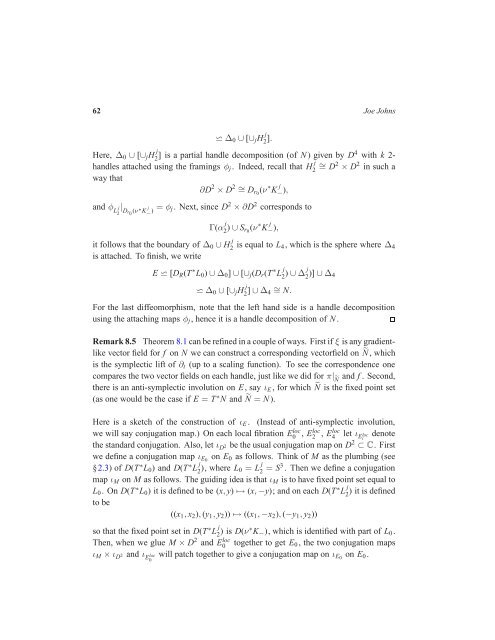The Picard-Lefschetz theory of complexified Morse functions 1 ...
The Picard-Lefschetz theory of complexified Morse functions 1 ...
The Picard-Lefschetz theory of complexified Morse functions 1 ...
Create successful ePaper yourself
Turn your PDF publications into a flip-book with our unique Google optimized e-Paper software.
62 Joe Johns<br />
⋍ ∆0 ∪ [∪jH j<br />
2 ].<br />
Here, ∆0 ∪ [∪jH j<br />
2 ] is a partial handle decomposition (<strong>of</strong> N ) given by D4 with k 2handles<br />
attached using the framings φj. Indeed, recall that H j<br />
2 ∼ = D2 × D2 in such a<br />
way that<br />
∂D 2 × D 2 ∼ = Dr0 (ν∗K j<br />
− ),<br />
and φ j<br />
L |<br />
2<br />
Dr0 (ν∗K j<br />
− ) = φj. Next, since D2 × ∂D2 corresponds to<br />
Γ(α j<br />
2 ) ∪ Sr0 (ν∗ K j<br />
− ),<br />
it follows that the boundary <strong>of</strong> ∆0 ∪ H j<br />
2 is equal to L4, which is the sphere where ∆4<br />
is attached. To finish, we write<br />
E ⋍ [DR(T ∗ L0) ∪ ∆0] ∪ [∪j(Dr(T ∗ L j<br />
2<br />
⋍ ∆0 ∪ [∪jH j<br />
2 ] ∪ ∆4 ∼ = N.<br />
j<br />
) ∪ ∆ )] ∪ ∆4<br />
For the last diffeomorphism, note that the left hand side is a handle decomposition<br />
using the attaching maps φj, hence it is a handle decomposition <strong>of</strong> N .<br />
Remark 8.5 <strong>The</strong>orem 8.1 can be refined in a couple <strong>of</strong> ways. First if ξ is any gradientlike<br />
vector field for f on N we can construct a corresponding vectorfield on N , which<br />
is the symplectic lift <strong>of</strong> ∂t (up to a scaling function). To see the correspondence one<br />
compares the two vector fields on each handle, just like we did for π|eN and f . Second,<br />
there is an anti-symplectic involution on E, say ιE , for which N is the fixed point set<br />
(as one would be the case if E = T∗N and N = N ).<br />
Here is a sketch <strong>of</strong> the construction <strong>of</strong> ιE . (Instead <strong>of</strong> anti-symplectic involution,<br />
denote<br />
we will say conjugation map.) On each local fibration E loc<br />
0<br />
2<br />
, Eloc<br />
2<br />
, Eloc<br />
4 let ι E loc<br />
i<br />
the standard conjugation. Also, let ι D 2 be the usual conjugation map on D 2 ⊂ C. First<br />
we define a conjugation map ιE0 on E0 as follows. Think <strong>of</strong> M as the plumbing (see<br />
§2.3) <strong>of</strong> D(T ∗ L0) and D(T ∗ L j<br />
2 ), where L0 = L j<br />
2 = S3 . <strong>The</strong>n we define a conjugation<br />
map ιM on M as follows. <strong>The</strong> guiding idea is that ιM is to have fixed point set equal to<br />
L0. On D(T ∗ L0) it is defined to be (x, y) ↦→ (x, −y); and on each D(T ∗ L j<br />
2<br />
to be<br />
((x1, x2), (y1, y2)) ↦→ ((x1, −x2), (−y1, y2))<br />
) it is defined<br />
so that the fixed point set in D(T ∗ L j<br />
2 ) is D(ν∗ K−), which is identified with part <strong>of</strong> L0.<br />
<strong>The</strong>n, when we glue M × D 2 and E loc<br />
0 together to get E0, the two conjugation maps<br />
ιM × ι D 2 and ι E loc<br />
0<br />
will patch together to give a conjugation map on ιE0 on E0.
















